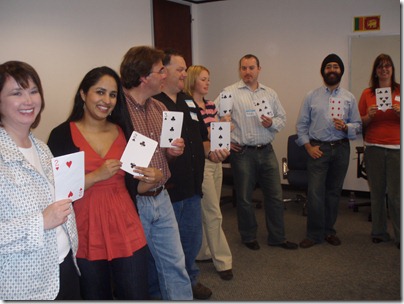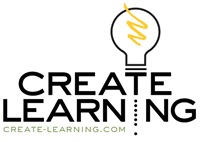
DiSC Team Building & Leadership simulations and activities can add application and understanding to your existing programs. There are many variations from conversational models to highly active models. Contact Mike… to discuss how to increase the learning and utilization of your DiSC training program.
Steady Changing
S-Steadiness focus activity
DiSC Objective
- DiSC Team Building Activity; Used to flex their S – Steadiness Preference.
- For participants to experience an S – Steadiness type culture. In this activity, all people are asked to use their Steadiness behavior to support the team and get satisfaction from helping others be successful.
- Because people have differing amounts of influence in their behaviors, team members need to be thoughtful and reflective of when Steadiness is needed and useful for team success.
Activity Objective:
Using mixed resources, the team must line up from greatest to least and continually help complete the task.
Materials:
- DiSC Profile
- Deck of Playing Cards Or a set of cards numbered 1 – 24
- Stopwatch
Instructions
Remind the entire team to think S-Steadiness from their DiSC Profile:
- People strong in the S dimension have a low need for control and a high need for affiliation. They are friendly, helpful, supportive, and genuinely care about people and get satisfaction from doing things for others. Supportiveness is another “S” word that I think is good for this style.
For more information about the other DiSC, behaviors go to your DiSC Profiles.
“This activity explores dealing with changes. Each of you will be given a card. Please do not turn it over and look at it until you are told to do so.”
“Your group will be given a series of challenges. After each challenge is identified, your group will have several opportunities to plan and find solutions. The goal is to execute the solution as effectively and quickly as possible while focusing on strengthening your DiSC S-steadiness as individuals and a team. Once you have had a chance to improve your solution, a new challenge occurs; the group will attempt to develop a plan that will produce levels of productivity and effectiveness similar to those exhibited during previous problems.”
Guidelines
- Hand out a card to each person. (It doesn’t matter if the numbers selected are sequential, as long as each person has a card.)
- Remind people that the goal is to develop and implement a solution as quickly as possible and be timed on their execution. Tell the group that they must signal you once they have finished the task, so the time is stopped.
- Tell people Challenge #1: turn your card over and line up in numerical order from smallest to the largest number.
- After they finish, tell the group the time on this attempt – this time is their first benchmark.
- Ask the group to shuffle the cards by having each person trade cards at least three times with someone different. Once they get a card to refrain from looking at it until told to do so. Give them a few minutes of planning time to refine their solution.
- Remind the group that the challenge is the same as before. The numbers are the same; the only different thing is who is holding the number.
- Give them a start signal and time the solution. Report the time to them.
- Allow 1 or 2 more attempts until you think they have achieved a good time, shuffling the cards between each attempt.
- Make a change by announcing Challenge #2: line up alphabetically by the letters of the number on your card you hold. Say “start” and time the attempt.
- Report the time to the group, and then repeat rules 5 – 8 as appropriate.
- Make another change by announcing Challenge #3: Line up in two lines – Odd numbers in one line, even numbers are the other – odds in descending order and evens in ascending order numerically.
- Report the time to the group, and then repeat rules 5 – 8 as appropriate.
Facilitator Notes
Between challenge #2 and #3, ask the group to spend some time planning how to respond to the next change. See if they can identify some ideas to help them organize and act even though they will not know what the change will be. The immediate goal is to lower their time for a first solution once a change is announced.
When people exchange cards, some groups will think of “innovative strategies” for circumnavigating the intent of the shuffling rule. For example, they will pass cards up and down the line so that they stay in the same order; they will pass the cards back and forth to specific people, so they know the location of each number; or, they will pass the cards randomly and then show it to others while insisting that they do not “know” the number on their card. Obviously, each of these solutions is a double-edged sword. You can admire and appreciate the out-of-the-box thinking, or you can reject the idea because it is counter to the spirit of the rule if not its intent. The more specific you are in presenting what is allowed and what is prohibited during the shuffling process, the less bending of the rules you will observe. However, recognize that you may alter the course of the activity by preventing certain types of thinking. Be deliberate about what you want as outcomes. If they include creativity and innovation, you may not want to prohibit some of the ideas above.
Some groups will also write information on the back of the cards to line up faster. As in the examples above, the strategy exhibits creativity. It is typically not prohibited because it is viewed as adhering to the spirit of the rules. Again, as the consultant, you need to determine what types of outcomes you want to achieve and present the rules to achieve those goals. These examples are intended to give you advance information to help you think through how you want the experience to unfold.
Learning & Application
The processing aims to explore how the team worked together and what strategies they created to deal with changes.
- What strategies did the group develop to implement effective solutions?
- What was the consequence(s) of change during the activity?
- Was it different if the changes were “minor” (i.e., shuffling the cards, but the same numbers were always in use) or “major” (i.e., changing from lining up numerically to lining up alphabetically)?
- Did the group manage to develop solutions to each major change that produced significant improvement in their time? How?
- What strategies did the group develop to adjust to change? What worked and what did not?
- What recommendations does the group have for managing change at work based on this experience?
Learning & Application of DiSC
Share the below image on a slide or handout with the team:

- When is S-Steadiness needed within our team?
- Based upon what we just did, where on the above image, did the team spend most of its time?
- Where did you find yourself spending much of your time?
- If we were to operate more in the steadiness quadrant, what would our actions be like amongst each other? Amongst our managers? Amongst our customers?
- How is steadiness already a strength? In what way? What else? What else?
- In what way may we use our Steadiness, which we already have, better?
- How would we know that it was better?
- How would our customers know?
- What is one thing we can do today to increase our steadiness as a team?
- What signs will we look for to measure the progress of this goal?
Mike can lead a train-the-trainer workshop for your team, click here to learn more.

